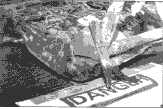Skydiving
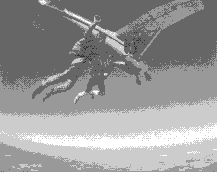
As the freefalling skydiver deployed his main parachute and stabilized under the blossoming canopy, the sight of an aircraft in close proximity shocked him out of his freefall high. The aircraft almost immediately banked into a steep turn to avoid the imminent mid-air collision.
That scene has been repeated all too often and has resulted in fatal accidents. There are numerous skydiving clubs across Canada, mostly at uncontrolled aerodromes, but a few operate at larger airports with a control tower or flight service station (FSS). And over the past few years, I have watched the comings and goings of numerous pilots across our local drop zone. Overflying pilots appear to be unaware of the skydiving activity and often fail to respond when I try to contact them on the radio.
At the Drop Zone
Parachutists normally leave the plane somewhere between 2500 and 12,500 ft. AGL. If they exit the plane at 2500 ft., they will open their parachutes almost immediately. If they exit at 12,500 ft., they will freefall for about 60 seconds before opening their parachutes at 2500 ft. Parachutists always exit the plane upwind of their intended landing site. If the wind is calm, they will exit directly overhead the landing site. If the wind is 10 to 20 kt., they will exit about 1/2 mi. upwind. On very windy days, the exit point could be a mile or more upwind.
Planes used for skydiving are either climbing or descending. There is never a level-off, cruise phase. As a result, the pilot is never in the best position for seeing out of the plane. All due caution is exercised, but it is difficult to see out of the windscreen when the nose is high. The descent phase is very rapid. The plane is flying quickly and has a high rate of descent.
If you wish to land at, or fly past, an airport where skydiving is taking place, the best tool is your radio. On the right frequency, you can determine where the jumpers are, and you can advise the jump-plane pilot of your position and intentions.
Arrival Procedures
If there is an FSS or a control tower at the airport, it is easy. Simply follow the directions you are given. The specialist or controller has the big picture and can keep you clear of any jump operations.
However, most drop zones are at uncontrolled airports, and arrivals there are not quite so easy. There usually is no one to give you the wind direction or the preferred runway. You have to overfly the airport in order to see the windsock. Once you know the wind direction, you can decide on the best runway. Using this technique at an airport where skydiving is in progress can be hazardous, simply because there will likely be open parachutes below 2500 ft. AGL in the area.
Arrival at a drop zone should start well back from the airport. Listen for a while; jump pilots make general broadcasts when the jumpers are getting close to exiting and again right at exit time. If you hear a jump plane, you can ask for the winds and runway in use. If you do not hear any activity, make a blind broadcast. To be safe, make this request or broadcast a few times as you get closer. Depending on how busy the drop zone is, it may take a couple of tries before you get an answer. Plan your arrival such that you do not overfly or fly upwind of the airport. This may necessitate a wide circuit of two or more miles from the airport. If the drop zone is active, it might be safer to do a right-hand circuit, entering on the base leg or even doing a straight-in approach. Ensure that you keep the other traffic informed of your intentions.
If you do not get a response to your radio calls, perhaps no one is in the air, or perhaps the jump-plane either does not have a radio or the pilot is not using it. Err on the side of caution and assume that there are parachutes in the air. Fly as close to the airport as necessary to determine the wind direction, but no closer. Make this pass on the downwind side of the airport at 90° to the forecast wind. This will minimize the time that you are in the area where parachutes might be. If you have two people on board, give the non flying person the job of looking for parachutes while the pilot assesses the wind direction. Make frequent radio broadcasts informing other traffic of your intentions.
Transiting the zone
The best advice is simply not to overfly a drop zone. Pass at least 5 mi. away from the aerodrome. Monitor the published frequency and broadcast your position, altitude and intentions. If you do overfly, broadcast when overhead and when clear of the zone so that the pilot knows when it is safe to let the skydivers exit their aircraft. Keeping people informed is your best defence.
Donald Gravelle
Gananoque, Ont.
Don is a commercial pilot who flies jump planes and is an active parachutist.
Originally Published: ASL 2/1997
Original Article: Skydiving
Birds and Windshields
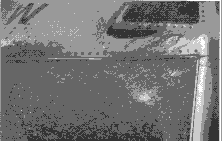
B737 windshield
All airplane windshields are manufactured to the same airworthiness standards? The windshield on your general aviation (GA) airplane or light helicopter offers protection from more than just rain, snow and bugs? If you believe these statements, then you could be in for a rude surprise.
In the Aviation Safety Letter, Issue 3/96, we discussed the loss of a PA-28 pilot and airplane en route from Brampton to Hamilton, Ontario, in February 1994. The cause of the crash was most likely a gull penetrating the windshield and blinding the pilot. In the Aviation Safety Vortex, Issue 4/95, we described the results of a western grebe striking the windscreen of a Bell 206 helicopter over Kelowna, British Columbia. If it weren't for the fact that the pilot was wearing a helmet with the clear visor down, the story might have ended in a fashion similar to the PA-28 accident. Worldwide, numerous fatal accidents are reported involving civilian and military airplanes that are lost owing to bird strikes on windshields. The reports follow a pattern similar to that of a Cessna 402 in Kenya that struck an eagle over Masai-Mara in 1985. The pilot was killed instantly, and the airplane crashed, killing everyone on board.
GA airplanes and helicopters are not the only aircraft vulnerable to bird-strike windshield damage. The photograph shows the damage caused to a Kenya Airways B737 that struck a European white stork at 10,000 ft. in 1993. The strike destroyed the windshield and penetrated the fuselage, and broken glass seriously injured the captain. The first officer was able to perform an emergency landing, thereby avoiding tragedy.
Closer to home, on November 14, 1996, an Air Ontario DHC-8 made an emergency landing at Ottawa after the windshield was damaged by a bird strike. The photograph tells the story. Data from ICAO member states from 1980 to 1992 describe 25 significant strikes to windshields involving transport airplanes. Of these, 4 resulted in injury to the flight crew and 8 required precautionary landings. Current airworthiness standards for transport category airplanes (over 12,500 lb.) require that windshields and surrounding structures be capable of withstanding a 4-lb. bird strike at cruise speed from sea level to 8000 ft. Concerns have been raised by ICAO members, particularly India, that the standard should be revised, owing to an increasing number of damage reports involving larger birds. Studies conducted by the USAF support the need to raise the standard to 4.5 lb., and recent developments by the Wright Laboratory have led to the use of injection-molded transparencies in some military aircraft that can withstand remarkable impact forces.
Standards for commuter-category airplanes (between 12,500 and 19,000 lb. and/or 10 to 19 passengers) require that the windshield in front of the pilots be able to withstand a 2-lb. bird strike at maximum flap speed, and transport-category helicopters (over 6000 lb.) must be able to withstand a 2.2-lb. bird strike anywhere on the structure, allowing for continued safe flight and landing for category A operations, and safe landing for category B operations.
Now that we know about the airworthiness standards for transport- and commuter-category airplanes, what about the standards for normal-category airplanes (under 12,500 lb. and 9 or fewer passengers) and helicopters (under 6000 lb. and 9 or fewer passengers)? The page here is blank; there are no requirements. The fact is that the windshield on your normal GA airplane or helicopter is only designed to keep out rain, snow and bugs. Knowing that, at 110 kt., the force of a 1-lb. bird (a small gull) striking the windshield of your light airplane can exceed 1200 lb. per square inch, you may wish to read on and learn how to avoid becoming part of our database.
In 1995, 81 incidents reported to Transport Canada involved bird strikes to windshields. Of these reports, 7 involved damage to the windshield structure. As a GA or helicopter pilot, what measures can you take to ensure that you do not become a statistic? First of all, don't fly in the same airspace as the birds. Birds seldom fly above 1500 ft. AGL, so it makes sense to plan your flights to spend as little time as possible at lower altitudes. Also, if you fly routinely in the same area, you might want to do some research to determine where birds such as gulls (the most commonly struck bird) feed and spend the night. You don't want to be flying at low altitudes on the flight paths that gulls use to move between their roosting sites on lakes or rivers and feeding sites such as landfills. You should also avoid flying over freshly plowed or harvested fields, and, during the spring and fall migrations, you definitely want to keep your eyes open for flocks of waterfowl such as Canada geese. These birds will fly at altitudes up to 15,000 ft. ASL, so be wary. Caution is advised when you are flying in areas where there may be strong updrafts, such as the windward side of hills and mountains. Birds of prey and some flocking birds will take advantage of an opportunity to gain free altitude. In particular, don't underestimate the damage that a bird can do to an airplane. Several accident reports from the United States describe GA pilots intentionally flying into bird flocks to see what might happen. They didn't survive to tell the story.
Fly with your landing, strobe and navigation lights on at all times. It can't hurt to make your airplane as visible as possible. Try to keep your speed low whenever it's safe to do so at lower altitudes. The force of a bird strike is determined by the square of your speed multiplied by the mass of the bird, and so the most important factor is your speed. If you see birds, and can safely pull up, do so: birds under threat tend to dive, so don't dive with them. Finally, if your airplane is stabilized on final approach and you experience a bird strike, continue on and land. There are numerous reports of accidents occurring because of an unsuccessful overshoot following an otherwise non-damaging bird strike.
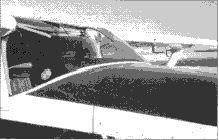
Skylane's shattered windshield
At the airport, you may wish to reconsider your takeoff decision if you see large numbers of birds in the vicinity of the runway. Call ATC, the FSS or the airport operator to request that the birds be dispersed. If you consistently see large numbers of birds in the airport environment, you might want to lobby the airport operator to do a better job of managing its facility. Remember, the operator is in the business to provide a service to pilots and airlines, and is required to operate a safe facility.
If you happen to be unlucky and a bird penetrates your windshield, remember that your primary focus should be on flying the airplane. If you can see it coming, duck your head below the instrument panel, or at least cover your face to protect your eyes from debris. Try to ignore the wind blast, bird remains, noise, and the fact that your headset will likely blow off and you will be unable to see your instrument panel. (If you have trouble with this part, try sticking your head out of your car at highway speeds, then imagine the turmoil at twice that intensity.) Follow correct flying procedures, and find an airport to make an emergency landing. All helicopter pilots should be wearing helmets with the visors down, and those in fixed-wing airplanes may prevent eye injury by wearing good-quality sunglasses. (It may not look cool, but wearing a helmet and visor in a light fixed-wing aircraft isn't such a bad idea.)
Finally, if you are a flight instructor, or are associated with a flying school or club, advise your colleagues or students that bird strikes are a serious matter and deserve to be part of your risk-management program.
Originally Published: ASL 2/1997
Original Article: Birds and Windshields
Stacking the Odds in the Mountains
The MU 300 Diamond touched down in the first thousand feet of the bare and dry 4500 ft. Jasper Hinton runway. The captain applied maximum braking, but he quickly realized that he would not be able to stop on the runway remaining. He initiated a series of "S" turns, believing that, by increasing the distance travelled, he would improve his chances of stopping before running off the pavement. He could not.
The aircraft skidded to a stop 225 ft. off the end, with the left main and nose gears collapsed. Numerous wrinkles in the fuselage skin and structure indicated serious airframe damage. Jet fuel leaked into the ground from the ruptured left wing tank (TSB Report A95W0034). Thankfully, fire did not break out, and the four on board walked away uninjured.
Both pilots had flown into Jasper Hinton before. So how did this experienced crew stack the odds so high against a successful landing?
At the pre-flight planning stage, the crew might have noted that there are no readily available weather observations for the Jasper Hinton aerodrome. (There are automated observations recorded at Jasper Hinton, stored and forwarded twice daily to Environment Canada. Human observations have since ceased at Jasper, also replaced by an autostation. Neither of these autostations meet aviation standards. There is an Automated Weather Observation System (AWOS) in Edson, 45 mi. east of Jasper Hinton. Since 1991, these observations have been available on normal weather information circuits and were available to ATS. They are not available by local voice generator module.)
At the time, the nearest official weather observations were taken at the Jasper townsite, 7 NM from the Jasper airstrip, and 30 NM from the Jasper Hinton aerodrome and separated from it by 8000 ft. mountains. When the FSS briefer gave them the "Jasper" weather, the crew members assumed that they were getting Jasper Hinton information and the specialist was merely abbreviating the name. They made the same assumption later when the Edmonton Centre controller passed them the latest "Jasper" weather before clearing them for descent. The regulations require ATS to give pilots the nearest official weather and altimeter setting.
Potential name confusion is not unique to these two aerodromes. There are numerous opportunities across Canada to duplicate the mistake: Moose Jaw/Moose Jaw Muni; Edmonton Intl/Edmonton Muni; Cold Lake/Cold Lake Regional; Gods Lake/Gods Lake Narrows; and La Grande 3/La Grande 4, just to name a few. So if you are aiming for Gods Lake and are told that "Gods Lake Weather is...," beware: Gods Lake does not report weather. Gods Lake Narrows does, but it's 30 NM to the west of your destination.
While the weather was basically clear at both sites, the winds at Jasper were calm, while the winds at Jasper Hinton, on the other side of the mountain range, were out of the southwest at 14 kt., gusting to 21 kt.
Subsidence of the air coming out of the mountains and the funnelling effect of the valley to the west of the airport both mean that the Jasper Hinton winds are generally stronger. Because of the unpredictable variable winds, Jasper Hinton has three windsocks serving the one runway: one at each end, and a lighted sock at centre field.
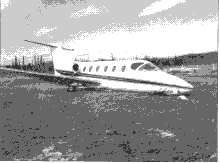
It is not unusual for winds and weather in the mountains to vary widely over short distances.
Previous experience (both pilots had been there before) and a pre departure review of aerodrome information should have reminded the crew that, except for the first 400 ft., Runway 02 has a distinct downslope.
Arriving at Jasper Hinton, the crew did not follow the procedures recommended for uncontrolled aerodromes. Those procedures suggest that a pilot should overfly the aerodrome prior to landing to determine wind and verify that the runway is unobstructed.
Believing that the winds were calm, and with 25 mi. visibility, the pilots did not feel that a visual inspection was needed. They proceeded with a straight in approach for landing on Runway 02.
On approach, the captain decided to add 10 kt. to the reference speed (Vref) to compensate for subsiding air, turbulence and airspeed fluctuations. (All of these factors should have alerted the crew to strong winds. Observing smoke, trees and water during their descent would also have warned them of the wind's strength and direction.)
On short final, the crew observed the windsock extended parallel to the ground and varying in direction. What they failed to take in was that it was not varying off the nose, but straight up the tailpipe.
So here's how the odds stacked up:
- inadequate preflight planning;
- winds and weather for a site 30 mi. away, on the other side of a high mountain ridge;
- a lack of appreciation of mountain weather;
- unclear preflight briefing and en route radio communications;
- disregard for recommended practices;
- failure to use the clues the strong winds were giving;
- observation of, but failure to see, the windsock; and
- a landing downwind, downslope, at 10 kt. above Vref.
A last second rejected landing might have saved the day, but, with those odds, the result was almost a sure bet.
Originally Published: 2/1997
Original Article: Stacking the Odds in the Mountains
Seat-Back Failure Causes Loss of Control
|
|
|
The Cessna 310 was observed in a cruise configuration low pass over the private strip. As the aircraft reached the end of the runway, the pilot pulled the aircraft into a steep climb. The aircraft continued to climb steeply until it stalled and entered a flat spin. It hit the ground with no forward speed. The pilot and his passenger died. The aircraft was destroyed in the ensuing fire.
The TSB (A95O0078) concluded that, when the pilot initiated the abrupt pull up, his weight overloaded the design specifications of the seat back, causing it to fail rearward. With the sudden G loading, the pilot fell backward when the seat failed, pulling the control column fully aft. Hanging back from the yoke, he was physically unable to recover from the low altitude stall/spin.
The TSB Engineering Laboratory confirmed that the seat met the design specifications set out in Technical Standard Order TSO 25a. The TSO requires that the seat support a 190 lb. pilot throughout all normal flight manoeuvres (maximum manoeuvring load of 2G). If the 380 lb. pilot (at double the weight in the certification standard) pulled the aircraft nose up to 45° in a smooth 2G manoeuvre, his weight on the back of the seat would have greatly exceeded the ultimate load limit. The Lab found that the seat back had failed in overload.
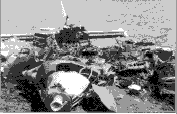
Non-survivable
Recognizing that people today are bigger, TSO-25a was changed in 1969 and again in 1983. However, there are still a lot of older aircraft built to the old design standards. Creative solutions might see periodic dye-penetrant testing or the x raying of seat fittings, medical restrictions on pilots' weight or a placard on the aircraft seat with a weight restriction on the pilots who fly these older birds.
Originally Published: 2/1997
Original Article: Seat-Back Failure Causes Loss of Control










